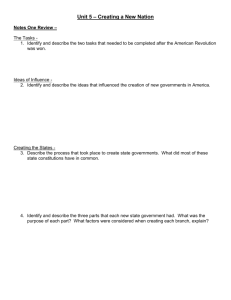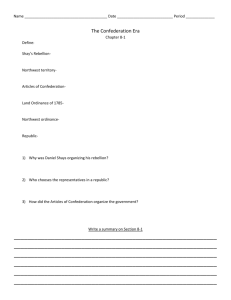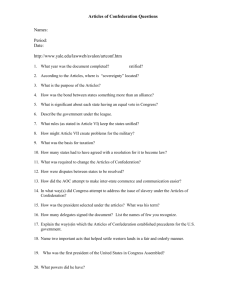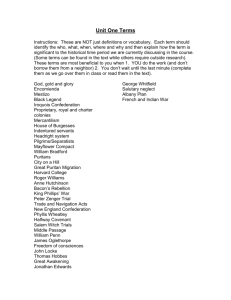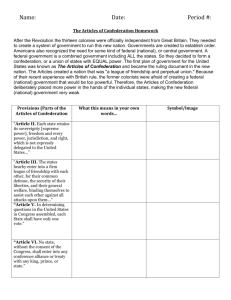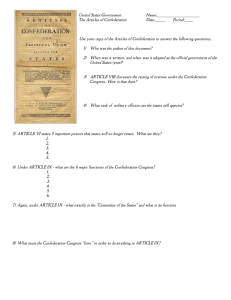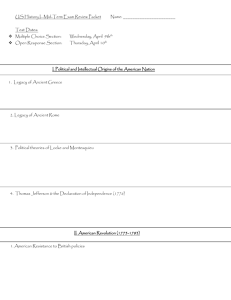Articles of Con PP
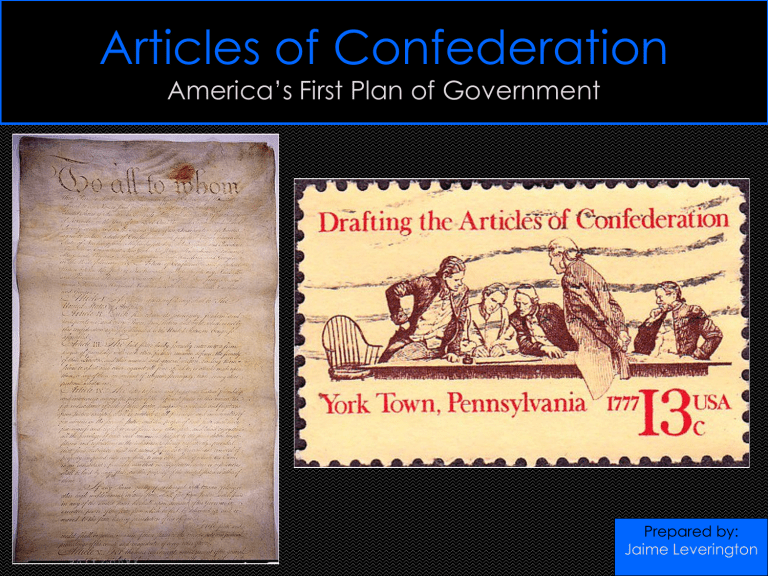
Articles of Confederation
America’s First Plan of Government
Prepared by:
Jaime Leverington
1
• Discussion Preview
– The Basics
• What are the Articles of
Confederation?
– The Reasons
• What beliefs about government contributed to their form?
– Governing
• How did the government operate under the
Articles of
Confederation?
– The Legacy
• What is the appropriate way to remember the
Articles?
In 1776, Benjamin Franklin designed this coin for the
Continental currency.
What is the message?
The Articles of Confederation
• What are the
Articles of
Confederation?
• What are the major features of the document?
2
The Articles of Confederation
Basics
3a
John Dickinson
Primary Author
• The major features of the document
– Each state retains its sovereignty
– In Congress, each state gets one vote
– In Congress, each state sends
2-7 representatives
– No executive power, no judicial power
– 13 states to ratify, took 13 to amend
– 9 states (2/3) to pass a law
The Articles of Confederation
Basics
3b
Samuel Huntington
President of Confederation
Congress, 1781
• The major challenges of governing under the Articles
– Unreliable method of tax collection
– No authority to regulate interstate commerce
– No national currency
– No power over individual citizens
– No way to enforce treaties in states, create uniform foreign policy
The Articles of Confederation
Basics
4
• The tax problem
– How were taxes to be collected?
– What happened when a State did not pay its tax bill?
The Articles of Confederation
Basics
• How do the
Articles of
Confederation reflect the
“Spirit of ’76”?
5
The Articles of Confederation
Reasons
“They believed that a federal government was one created by equal and independent states who delegated to it sharply limited authority and who remained superior to it in every way.”
From “ The Idea of a National Government ” by Merrill
Jensen, 1943 on page 357
• What beliefs about government are reflected by the
Articles of
Confederation?
6
The Articles of Confederation
Reasons
7
• “The price of union was an exaggerated… ….
solicitude for state’s rights” –
Peter S. Onuf
(page 91)
• According to Onuf,
How did
‘Confederation
Politics’
(pg 88) make the Articles of
Confederation an essential step toward union?
The Articles of Confederation
Reasons
8
• Case Study 1: The
Impost Tax
– Congress proposes a
5% tax on import goods
– Repeated efforts to amend Articles to allow impost tax fail
• Rhode Island blocks initial attempt
• Repeated attempts also fail.
– Tax revenue challenge is the greatest challenge, no solution under
Articles
Independence Hall, Philadelphia
The Articles of Confederation
Governing
9
• Case Study 2: Shay’s
Rebellion
– A farmer rebellion in
Western
Massachusetts
– Congress is unable to respond to it, private banks in Boston fund private army to put it down
– A failure of government to deal with internal security threats.
The Articles of Confederation
Governing
• Case Study 3: The
Northwest
Ordinance
– 60 Second Civics describes Northwest
Ordinance
– What does the
Northwest Ordinance accomplish?
10
– Audio Source
The Articles of Confederation
Governing
11
• Did Maryland make the difference?
• If Maryland would have ratified the
Articles earlier, they could have gone into effect in Feb.
1778, rather than
March of 1781.
• Could the Articles have survived if they were given those 2 years of legitimacy?
The Articles of Confederation
Legacy
12
• What is the appropriate way to remember the Articles of
Confederation?
“The failures of the Articles, often exaggerated for rhetorical effect, helped shape the new constitutional order that superseded them.”
“Most important, the Articles established a necessary framework for working towards a continental constitutional order.”
From “The First Federal Constitution: The Articles of
Confederation” by Peter S. Onuf on page 97
The Articles of Confederation
Legacy
